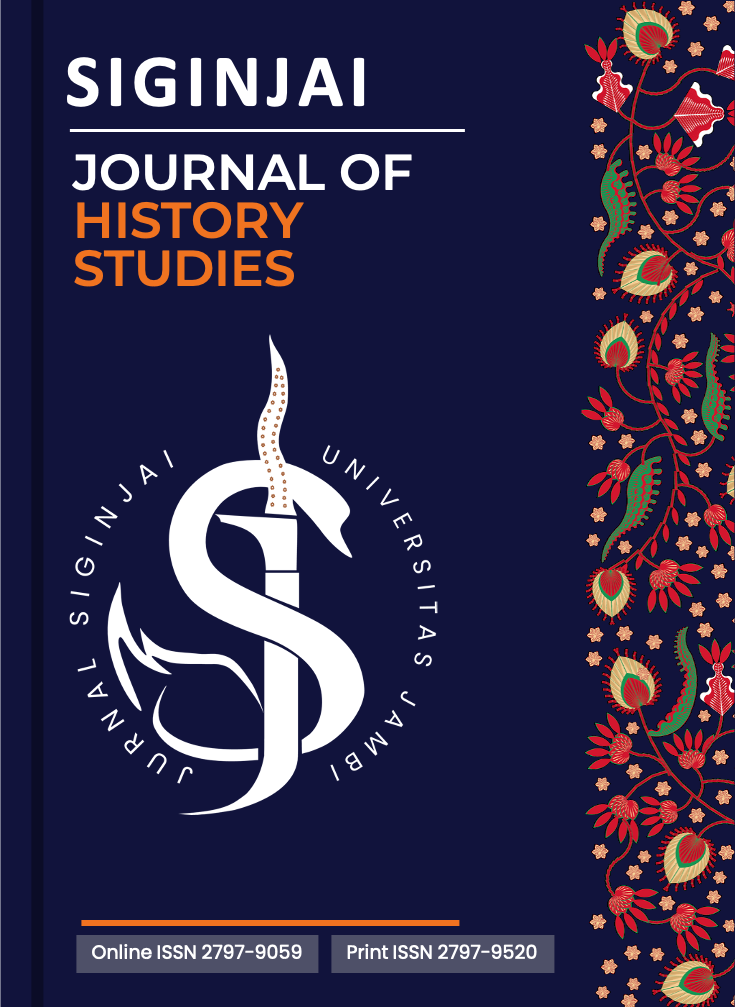Between State Duty and Peace Mission: The Other Side & Experience of Indonesia Peacekeeping Force in the Middle East
DOI:
https://doi.org/10.22437/js.v4i2.38152Keywords:
state duties, peacekeeper, missions, daily experiences, peacekeeper troops, Indonesia, Middle East.Abstract
Further research has been conducted on the role of the Indonesian National Army and the Indonesian laskar after the declaration of independence on 17 August 1945 and during the revolutionary period from 1945 to 1949. However, after decolonization in the 1950s, military history including the lives of its members and their personal lives received less space in the narrative of military history. Peace veteran is a title given specifically to young Indonesians who had participated as special forces under the auspices of the United Nations. These young men did not only come from the TNI but also from student regiments who had the opportunity to join this special peacekeeping force. The main focus of this article revolves around their efforts to guard the border between Egypt and ‘Israel’ during the war in the Middle East. This article will use oral sources and personal documents from various Indonesian peacekeeping forces who served during this period. The results of the study show that although they were faced with uncertain situations, far from their families, and preparing to face the enemy, there was another side to their experiences, namely, meeting colleagues from other countries, language gaps, and other “normal” activities that they were still able to carry out while on duty.
Downloads
References
Alex Woolf (2013). Living Through The Arab-Israeli War Since 1948, London: Raintreepublishers.
Anonim. (n.d.). UNEF I Background. Retrieved from https://peacekeeping.un.org/fr/mission/past/unef1backgr1.html
Anonim. (n.d.). What is the Suez Crisis? Retrieved from https://www-iwm-org-uk.translate.goog/history/what-was-the-suez-crisis
Anonim. Dharma Bhakti TNI dalam Tugas Internasional, Jakarta: Dinas Sejarah TNI AD, 1982
As’ad Gharen (2001). The Palestinian Arab Minority in Israel 1948-2000: A Political Study, New York: State University of New York Press.
Bali Post, “Langkah Mesir 10 Tahun Yang Lalu” 28 Desember 1988
Berita Yudha, “Sulitkah Mencari Titik Temu Arab-Israel?”, 25 Juni 1983
Harian Abadi, “Dengan Gencatan Senjata Mesir Menang Politis”, 24 Oktober 1973.
Harian Abadi, “Dubes Mesir Ali Shawky El Hudidy, Perang Sekarang Perang Pembebasan Seluruh Negara Arab Telah Bersatu”, 10 Oktober 1973
Harian Abadi, “Mesir Kini Berkemampuan Untuk Menyerang Lagi, 7 November 1973
Harian Abadi, “Perang Ke- 5 Mesir-Israel Bisa Meletus”, 8 Desember 1973
Harian Abadi, “Pertempuran Sengit Berkecamuk di Sinai & Golan”, 9 Oktober 1973.
Harian Abadi. (1973, Desember 21). Gel I Garuda VI Berangkat.
Harian Abadi. (1973, November 15). Kotindo Garuda VI Ke Timteng diberangkatkan 2 Gelombang.
Harian Abadi. (1973, November 15). Perundingan Mesir-Israel Alami Jalan Buntu.
Herzog, C., & Gazit, S. (2005). The Arab-Israeli Wars: War and Peace in the Middle East from the War of Independence through Lebanon. New York: Vintage Books.
Hitman, Gadi (2016). Israel and Its Arab Minority 1948-2008 “Dialogue, Protest, Violence. UK: Lexington Books.
Ilan Pappe (1993). Britain and the Arab-Israeli Conflict 1948-1951, Oxford: Macmillan Press.
Jawa Pos. (1978, Februari 28). Garuda VIII Semakin Populer di Timur Tengah.
Khalidi, R. (2006). The Iron Cage: The Story of the Palestinian Struggle for Statehood. Boston: Beacon Press.
Kochhar, S. K. (2008). Pembelajaran Sejarah. Jakarta: Grasindo.
Kyle, K. (2011). Suez: Britain's End of Empire in the Middle East. London: I.B. Tauris.
Latief, J. A. (2015). Manusia, Filsafat dan Sejarah. Jakarta: Sinar Grafika Offiset
Martani, W. R., Sumertha, I. G., & Hidayat, E. R. (2020). Peran Standby Force Pusat Misi Pemeliharaan Perdamaian Tentara Nasional Indonesia (PMPP TNI) dalam mempersiapkan pasukan pada misi pemeliharaan perdamaian. Jurnal Diplomasi Pertahanan, 6(1), 52-74.
Morris, B. (2008). 1948: A History of the First Arab-Israeli War. New Haven: Yale University Press.
Mulia Sihombing, Wawancara, 5 Sept 2024
Mulyadi, Wawancara, Puri Masurai 2, 7 Juli 2024
Mustofa, Amira N. et al, Past (1950-2017) and Future (-2100) Temperature and Precipitation Trends in Egypt. Weather and Cliate Extremes, 26 (.). 1-12. 2009., p. 3 https://doi.org/10.1016/j.wace.2019.100225
Nasution, A. H. (1985). Tentara Nasional Indonesia: A National Study. Bandung: Penerbit Angkasa.
Oren, M. B. (2002). Six Days of War: June 1967 and the Making of the Modern Middle East. New York: Oxford University Press.
Prasetyo, A. (2010). Garuda di Bawah Panji PBB: Kisah Kontingen Garuda dalam Misi Perdamaian. Jakarta: Gramedia Pustaka Utama.
Shlaim, A. (2001). The Iron Wall: Israel and the Arab World. New York: W.W. Norton & Company.
Sudirman, Wawancara, Kantor LVRI Provinsi Jambi, 2 Juli 2024
Syamsurizal, Wawancara, Kantor LVRI, 5 September 2024
Tabiin, Wawancara, 18 Juli 2024.
Yigal Allon (1970). Shield of David: The Story of Israel’s Armed Forces, Plunkett Lake Press.
Downloads
Published
How to Cite
Issue
Section
License
Copyright (c) 2024 Zulfa Saumia, Devi Itawan, Padhil Hudaya, Richad Saputra Adiguna, Inda Lestari

This work is licensed under a Creative Commons Attribution 4.0 International License.















